
Nilssonia is a genus of softshell turtles from rivers, streams, ponds, and lakes in South Asia and Burma. In many treatments, it is monotypic, with the single species Burmese peacock softshell. However, the supposed other genus of peacock softshells, Aspideretes, is more closely related to N. formosa than had been believed. They differ only in the neural plates between the first pleural scale pair of the bony carapace, which are fused into one in N. formosa and unfused in the others.

Acanthochelys is a genus of turtles, the spiny swamp turtles, in the family Chelidae, subfamily Chelinae, found in South America. Until recently, the species of this genus were considered to be members of the genus Platemys, but were moved to the resurrected genus originally described by Gray (1873) based on the type species by monotypy Acanthochelys spixii.
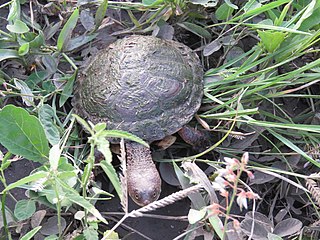
The Chaco side-necked turtle or Chaco sideneck turtle is a species of turtle in the family Chelidae. It is found in Argentina, Paraguay, and possibly Bolivia. Its natural habitat is subtropical or tropical moist montane forests. The turtle possesses long horny spurs on its upper thighs. It is 18 cm in shell length. Like other members of its genus, the turtle buries itself in the mud when the streams run dry, a behaviour possibly parallel to the winter hibernating behaviours of turtles further north.
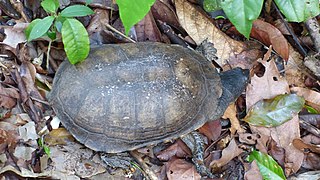
The Brazilian radiolated swamp turtle is a species of turtle in the Chelidae family endemic to Brazil.

Parker's snake-necked turtle is a species of turtle in the family Chelidae.
Pritchard's snake-necked turtle is a species of turtles in the family Chelidae. The species is endemic to a restricted area of Central Province, Papua New Guinea.
Reimann's snake-necked turtle is a species of turtle in the family Chelidae. The species is endemic to Oceania and Southeast Asia.

Elseya is a genus of large side-necked turtles, commonly known as Australian snapping turtles, in the family Chelidae. Species in the genus Elseya are found in river systems in northern and northeastern Australia and throughout the river systems of New Guinea. They are identified by the presence of alveolar ridges on the triturating surfaces of the mouth and the presence of a complex bridge strut.

The red side-necked turtle, red turtle, red-footed sideneck turtle, William's toadhead turtle, or red-footed Amazon side-necked turtle is a monotypic species of turtle in the family Chelidae. It is found in Colombia and possibly Peru and Brazil. This species is dimorphic in size meaning the sexes show different characteristics. One study found that the largest female out of a group of 24 was 256 mm in carapace length. Out of that same group, the largest male was only 199 mm in carapace length.

The red-headed Amazon side-necked turtle, red-headed river turtle or red-headed sideneck is a species of turtle in the family Podocnemididae. It is found in the Amazon basin in Brazil, Colombia, and Venezuela.
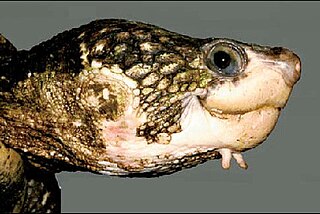
Elseya albagula, commonly known as the white-throated snapping turtle, is one of the largest species of chelid turtles in the world, growing to about 45 cm (18 in) carapace length.
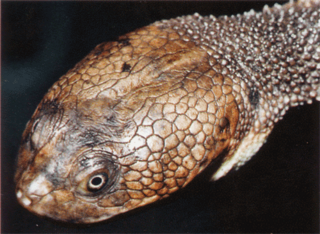
Chelodina canni, also known commonly as Cann's snake-necked turtle, is a species of turtle in the family Chelidae. The species is endemic to Australia, where it is found in the northern and northeastern parts of the continent. It has a narrow zone of hybridization with its related species the eastern snake-necked turtle, C. longicollis. For many years C. canni was assumed to be the same species as C. novaeguineae from New Guinea. However, in 2002 it was shown that these two species differ both morphologically and genetically, and therefore C. canni was separated and described as a unique species.

Chelodina (Chelydera) burrungandjii, the sandstone snake-necked turtle or Arnhem Land long-necked turtle, is a medium-sized turtle reaching carapace lengths of 316 mm. The species is found in the sandstone plateaus and escarpments and the plunge pools of Arnhem Land of the Northern Territory. The species had been long recognised as valid. However, it had been difficult to research due to the remoteness of its habitat. Efforts to breed this species in captivity had been largely unsuccessful, until National Aquarium Herpetologist Matthew Benedict lead a successful breeding project in 2021. The species occurs in proximity to Chelodina rugosa, to which it is closely related. For the most part the two species are parapatric in distribution. However, they do come together in limited locations such as plunge pools at the base of the escarpments. In these areas there is hybridization between the species.

The Chaco tortoise, also known commonly as the Argentine tortoise, the Patagonian tortoise, or the southern wood tortoise, is a species of tortoise in the family Testudinidae. The species is endemic to South America.

The Assam leaf turtle is a species of turtle in the family Geoemydidae. The species is found in India, Nepal, Bhutan, and Bangladesh.

Cyclemys enigmatica, also known as the enigmatic leaf turtle, is a species of Asian leaf turtle. It is found in the Greater Sunda Islands and the Malay Peninsula.

The western black-bridged leaf turtle is a species of Asian leaf turtle found in southern Indochina.

Emydura macquarii, is a wide-ranging species that occurs throughout many of the rivers of the eastern half of Australia. It is found primarily in the Macquarie River basin and all its major tributaries, along with a number of coastal rivers up the New South Wales Coast. It is also found in the coastal Queensland rivers and the Cooper Creek ecosystem, along with Fraser Island.

Elseya schultzei, commonly known as Schultze's snapping turtle, is a species of chelid turtle endemic to northern New Guinea.
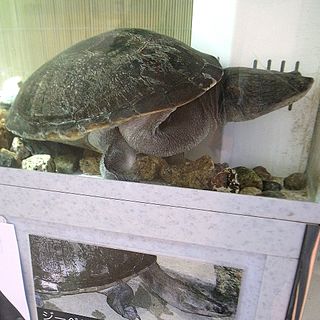
Chelodina (Chelydera) kuchlingi, commonly known as Kuchling's long-necked turtle or Kuchling's turtle, is a species of freshwater turtle in the family Chelidae. The species is endemic to Australia.



















